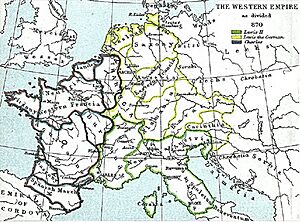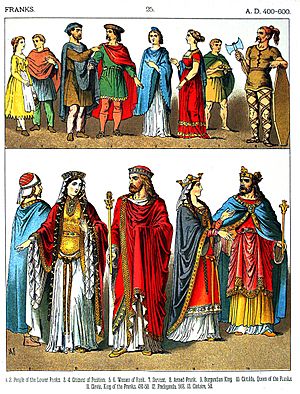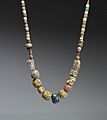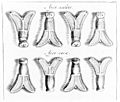Franks facts for kids
The Franks were a group of Germanic tribes. They came together to form a powerful group. These tribes included the Salians, Sicambri, and others. Most of them lived near the northern part of the Rhine River.
They moved into the Roman Empire from the north and east banks of the Rhine. They settled in what is now northern Belgium and the southern Netherlands. Later, they conquered more land. They built a lasting kingdom that covered much of modern-day France, Belgium, the Netherlands, and western Germany. A very important event happened when the Frankish king Clovis I became Christian in the late 400s.
Experts today believe the Frankish group started in the early 200s. A region in the northeast of the modern-day Netherlands is still called Salland. This name might come from the Salians, who were a main part of the Frankish sea raiders.
Contents
Frankish Empire: How it Grew
From their main lands, the Franks slowly took over most of Roman Gaul. This was the area north of the Loire River valley. It was also east of the Visigoths' lands. At first, the Franks helped the Romans protect their borders. For example, in 406, many East Germanic tribes invaded. The Franks fought against these invaders. In the Paris area, Roman control lasted until 486. This was ten years after the Western Roman Empire ended. This was partly because of their alliances with the Franks.
Merovingian Rulers
In 451, a Roman general named Aëtius asked his Germanic allies for help. He needed them to fight against an invasion by Attila the Hun. The Salian Franks helped him. Some Ripuarian Franks fought on both sides. This was because some of them lived outside the Roman Empire. The Merovingian kings had important officials called "Mayors of the Palace." These officials led the Franks in war and managed many government duties.
Carolingian Rulers
The Carolingian kings started ruling after the last Merovingian king was removed. This happened in 751 when Pepin the Short became king. He was the father of Charlemagne.
Pepin became king because he was chosen, not because he inherited the title. In later France, kingship became hereditary. But in the Holy Roman Empire, kings continued to be chosen by election until 1806.
In 768, Charlemagne (Charles the Great) became king. He was a strong, smart, and somewhat educated leader. He became a legend for both France and Germany. Charles brought back a balance of power between the emperor and the pope.
From 772 onwards, Charles conquered the Saxons. He added their lands to the Frankish kingdom. Then, from 773 to 774, he conquered the Lombards. This brought northern Italy under his influence. He also promised the Pope that the Franks would continue to protect the Vatican.
Charles created a huge kingdom. It stretched from the Pyrenees mountains in the southwest. It included an area in northern Spain after 795. It covered almost all of today's France (except Brittany, which the Franks never conquered). Eastward, it included most of today's Germany, northern Italy, and today's Austria.
On Christmas Day in 800, Pope Leo III crowned Charles as "Emperor of the Romans" in Rome. Charles preferred the title "Emperor, king of the Franks and Lombards." He did not want to cause problems with the Byzantine Empire. However, the Frankish Empire became the successor to the Western Roman Empire. Charles died on January 28, 814, in Aachen, where he was buried.

Charles had several sons, but only one outlived him. This son, Louis the Pious, became the ruler of the united Empire. When Louis died in 840, the Treaty of Verdun in 843 divided the Empire into three parts:
- Louis' oldest son, Lothair I, became Emperor. He ruled the Central Franks. His three sons later divided this kingdom into Lotharingia, Burgundy, and northern Italy. These areas later stopped being separate kingdoms.
- Louis' second son, Louis the German, became King of the East Franks. This area became the core of the later Holy Roman Empire and the beginning of Germany.
- His third son, Charles the Bald, became King of the West Franks. This area became the basis for the later country of France.
Related pages
Images for kids
-
A 6th century bow fibula found in north-eastern France and the Rhineland. They were worn by Frankish noblewomen in pairs at the shoulder or as belt ornaments.
-
A chalice from the Treasure of Gourdon.
-
The pinnacle of Carolingian architecture: The Palatine chapel at Aachen, Germany.
-
Drawing of golden bees or flies that was discovered in the tomb of Childeric I
-
Statue in the Basilica of Saint-Remi depicting the baptism of Clovis I by Saint Remi in around 496
-
Carolingian Empire (green) in 814
See also
 In Spanish: Pueblo franco para niños
In Spanish: Pueblo franco para niños












